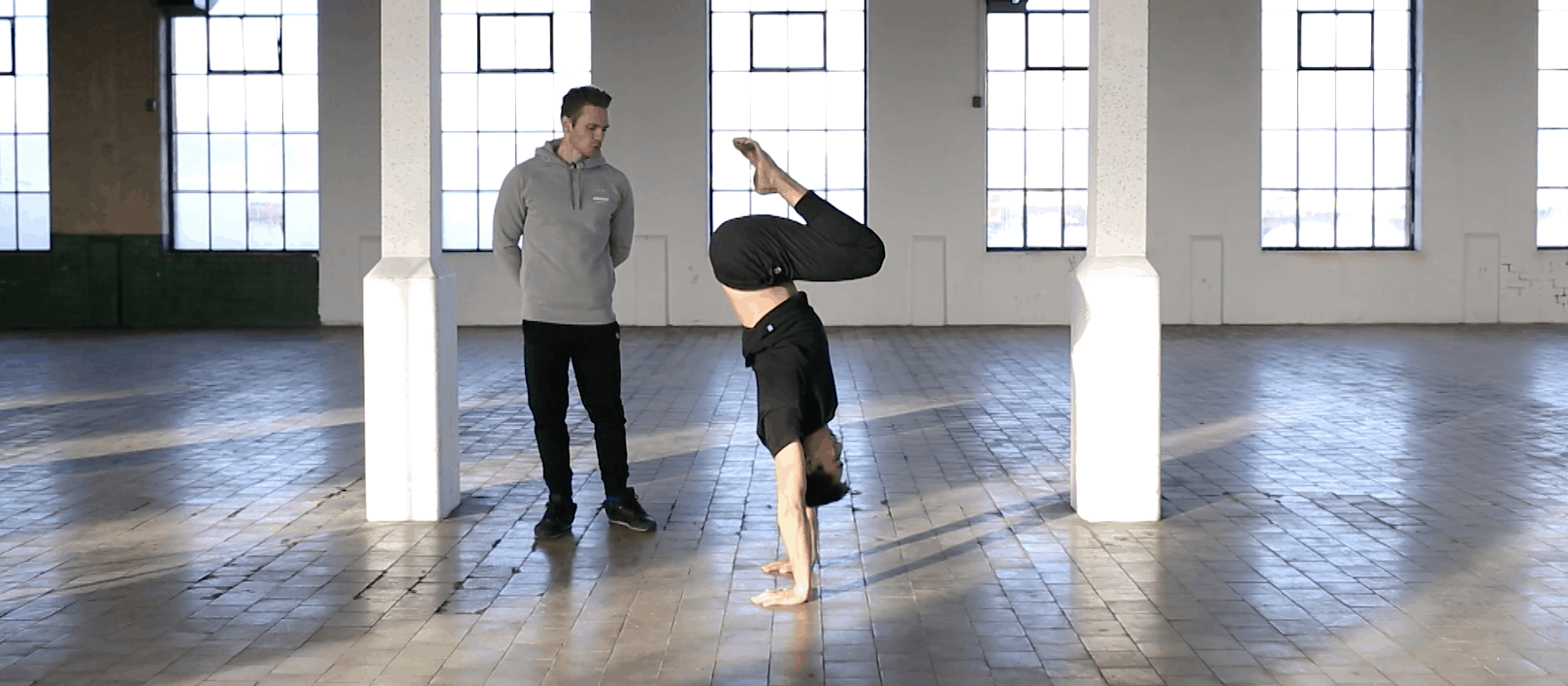Like many elements of the handstand, head position has a variety of orientations depending on your coach’s root discipline. At Handstand Factory we take a pragmatic approach regarding head position for beginners, and then purposefully variate it for higher level handbalancing.
Head Position for Learning the Handstand
For practical purposes, we encourage our beginners in the Push program to look at the ground when learning to handstand. Foremost, seeing the ground gives you awareness of your spacing if you start to fall, enabling you to better reorient yourself during your bail. Fixing your gaze between your hands also can provide you with some balance stabilization in the same way fixating your gaze on a non-moving object can improve your balance while upright. Lastly, the ground gives much less distracting visual information than the rest of your surrounding environment, allowing you to focus on your balance than what’s happening across the room.
Some schools will ask you to look at the ground, but try to keep your head neutral by “looking through your eyebrows” to spot the floor. We do not think this is necessary for good alignment, but can be an aesthetic choice, or simply feel more comfortable for some. If you look at professional handbalancers, most crane their neck to have their face oriented towards the ground, but there are some who keep a more neutral neck. As with many things, it comes down to preference – we recommend trying both face-to-ground and looking through your eyebrows to see if you have a personal preference regarding your head orientation.
Disassociate Head Movement from Balancing
While we coach beginners to look at the ground, the challenges that present themselves when moving the head in a handstand can be used as interesting balance training tools once you want to advance your handbalancing beyond a straight hold. Once you’ve achieved a consistent, freestanding handstand, we like to introduce other head positions as well as being able to move the head freely, which is why is it one of the 3 skill modules in our Expand program.
Learning to disassociate your head position from the balancing introduces two new variables in balancing:
1: Head movements while keeping the position of the head neutral or craned: The change in gaze challenges the visual balance system so that you can force your body to rely more on the proprioceptive and vestibular balance systems. You can train this by shaking your head “no” or nodding “yes”, looking left and right or doing full circles with your head.
2: The other two head positions are looking at the wall through your hands and looking up at your toes: On top of the challenge of shifting the gaze, the change in weight distribution of having the head in a different position makes you correct your handstand positioning to keep your centre of mass over your base of support, which makes this a great way to train different shoulder positions.
Disassociating your head movement from your handstand will overall improve your ability to balance by relying less on visual stabilization and more on vestibular feedback and also develop greater shoulder capacity for rebalancing. Both of these will aid in achieving skills like easier transitions into new handstand shapes or working towards the one-arm handstand.
Head In for the One-Arm Handstand
As we mentioned above, changing your head position can have great carry over to the one-arm handstand. The head-in placement changes your center of mass to a degree. A simple way to experience this is to do a handstand and move the head through the arms. You will most likely fall towards underbalance if you have not worked on it before. The reason for this is simple: you have moved more weight towards the heel of the palm, and to stay balanced you would have to make micro-adjustments to your positioning in order to keep the center of mass over your hands. The key is to focus on keeping the weight in the center of your hands before, during and after you decide to move your head.
We specifically use head in drills to bring the shoulders and ribs more in line with the positioning needed for the one-arm. Biomechanically, the head-in position restricts access to the anterior shoulder, chest and bent arms, but it increases the ability to elevate the shoulder and use the trapezius to elevate the scapula. In this way this head placement can force you into better shoulder placement in regards to working towards higher level skills, which is also why it is so useful in one-arm preparation. In the OAHS, the upper back muscles are much more heavily used to maintain balance. By shifting your head in while one two hands, you can move your weight to rely on the same muscles, since the anterior chain of your shoulder is no longer in a position to contract to rebalance you. Because it lights up these upper back muscles, head in drills not only teach your body the coordination for the OAHS, but they are also a great warmup exercise as part of a one-arm training session. For this reason, they are the first component we work on in our Push Harder program for learning the straddle one-arm handstand.
Head position will not make or break your handstand. But when leveraged consciously, it can become a useful tool to improve your balance, create aesthetic shapes, and build strength towards high level handbalancing skills.

